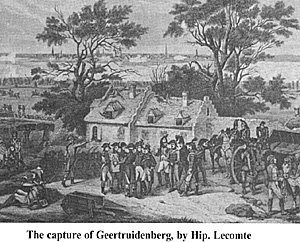The Capture of Breda
and Geertruidenburg 1793
Dutch During the
Revolutionary Wars Part 8
The Capture of Geertruidenberg
by Geert van Uythoven, Netherlands
| |
The capture of Geertruidenberg, by Hip. Lecomte. Possession of this fortress directly threatened the Dutch defence of the island of Dordrecht, and would effectively cover Dumouriez’ right flank during his advance north. Governor of Geertruidenberg was the eighty-year-old Lieutenant-General However, most of the inundations were put into effect to late, or quickly drained again by the French, assisted by Dutch patriots. When the French entered Dutch territory, two officers were despatched to aid Bedaulx in his preparations for defence. These were Captain Ulrich Huguenin of the artillery, and Captain-Engineer Seeger Tierens. They pointed out to Bedaulx the fact that most inundations were easily rained again, but Bedaulx took no measures to prevent this. On 26 and 27 February skirmishes took place near Waspik and the Raamsdonk Ferry. Immediately, the French drained the inundations by opening two sluices between Drimmelen and Zwaluwe. On 1 March Bedaulx decided to abandon the stronghold near Steelhoven, when d’Arçon himself arrived with the French main force. Making good use of the Dutch retreat, at Steelhoven the French used the abandoned stronghold to throw up a battery armed with two 10-pdr mortars and an 8-pdr howitzer. The next day Bedaulx ordered the evacuation of a second stronghold at Douk, which also promptly was occupied by French troops, commanded by Lieutenant-Colonel Guillaume baron Boyvin de la Martinière. He brought up both mortars from the stronghold at Steelhoven, supplementing them with an additional four mortars calibre 7 ½ ‘tirés’, Dutch pieces captured in and brought up from Breda. However, three of these mortars were in such a bad state that they destroyed their own carriages when they were fired for the first time. Therefore, d’Arçon ordered them to be replaced with two 12-pdr mortars and a 24-pdr cannon. This battery threw a few bombs and some red-hot ball into the city, which did not much damage. Expecting a regular siege, Bedaulx ordered a part of the paved streets to be broken up or covered with manure, to minimise the effect of cannon balls fired into the city. During the next days the French bombarded the city now and then, which caused a number of small fires and minor damage to the buildings. On the 4th Bedaulx evacuated a third stronghold at De Spuy, and at this place the French deployed another mortar of calibre 7 ½ ‘tirés’, and an 8-pdr howitzer. From this position, the French were able to fire right on the main street of the city. The erection of field works at the side of Statendam, capable of protecting more siege guns, obliged Bedaulx however to surrender the city at the second demand on the same day, without waiting for the proper siege to begin! The garrison left the fortress with drums beating and colours flying, after which the French took possession of it, capturing 150 cannon and mortars, 2,500 brand new muskets and much provisions, gunpowder and ammunition. More severe, the French captured thirty transport ships, the city in addition offering them a good harbour for their future operations. A Governor not capable for such a task delivered another city to the French without much resistance. Curiously, Bedaulx again became Governor after the French had surrendered the city again, only to hand over the city to them again two years later! BibliographyAa, Cornelis van der Geschiedenis van den jongst-geëindigden oorlog, tot op het sluiten van den vrede te Amiëns, bijzonder met betrekking tot de Bataafsche Republiek Dl 1 (Amsterdam 1802) te Amiëns, bijzonder met betrekking tot de Bataafsche Republiek Dl 1 (Amsterdam 1802)
Footnotes[1] The gendarmerie nationale, deriving from the anciens gardes-Françaises, were very bad and undisciplined troops, which
committed many crimes. Even Dumouriez despised them! Because of the lack of troops however he still had to use them.
Capture of Breda and Geertruidenburg 1793 Dutch in Revolutionary Wars Part 8
The Dutch During the Revolutionary Wars
|

 After the capture of Breda, without loosing any time, Dumouriez ordered maréchal de camp d’Arçon to advance to the fortress-city Geertruidenberg, to take advantage of the quick capture of Breda and to capture this city also.
After the capture of Breda, without loosing any time, Dumouriez ordered maréchal de camp d’Arçon to advance to the fortress-city Geertruidenberg, to take advantage of the quick capture of Breda and to capture this city also.